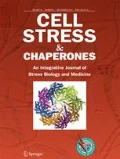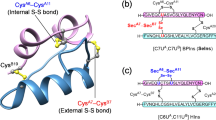Abstract
FKBP22 of a psychrophilic bacterium, Shewanella sp. SIB1 (SIB1 FKBP22), is a member of peptidyl-prolyl cis-trans isomerase (PPIase) and consists of N- and C-domains responsible for chaperone-like and PPIase catalytic activities, respectively. The chaperone-like activity of SIB1 FKBP22 was previously evidenced by its ability to prevent dithiothreitol (DTT)-induced insulin aggregation. Nevertheless, the mechanism by which this protein inhibits the aggregation remains unclear. To address this, the binding affinity of SIB1 FKBP22 to the native or reduced states of insulin was examined using surface plasmon resonance (SPR). The native and reduced states refer to insulin in the absence or DTT presence, respectively. The SPR sensorgram showed that SIB1 FKBP22 binds specifically to the reduced state of insulin, with a KD value of 37.31 ± 3.20 μM. This binding was facilitated by the N-domain, as indicated by the comparable KD values of the N-domain and SIB1 FKBP22. Meanwhile, the reduced state of insulin was found to have no affinity towards the C-domain. The KD value of SIB1 FKBP22 was slightly decreased by NaCl but was not severely affected by FK506, a specific FKBP inhibitor. Similarly, the prevention of DTT-induced aggregation by SIB1 FKBP22 was also modulated by the N-domain and was not affected by FK506. Further, the reduced and native states of insulin had no effect on the catalytic efficiency (kcat/KM) of SIB1 FKBP22 towards a peptide substrate. Nevertheless, the reduced state of insulin slightly reduced the catalytic efficiency towards refolding RNase T1, at up to 1.5-fold lower than in the absence of insulin. These results suggested that the binding event was mainly facilitated by hydrophobic interaction and was independent from its PPIase activity. Altogether, a possible mechanism by which SIB1 FKBP22 prevents DTT-induced insulin aggregation was proposed.









Similar content being viewed by others
References
Budiman C, Bando K, Angkawidjaja C, Koga Y, Takano K, Kanaya S (2009) Engineering of monomeric FK506-binding protein 22 with peptidyl prolyl cis-trans isomerase. Importance of a V-shaped dimeric structure for binding to protein substrate. FEBS J 276:4091–4101
Budiman C, Koga Y, Takano K, Kanaya S (2011) FK506-binding protein 22 from a psychrophilic bacterium, a cold shock-inducible peptidyl prolyl isomerase with the ability to assist in protein folding. Int J Mol Sci 12:5261–5284
Budiman C, Lindang HU, Cheong BE, Rodrigues KF (2018) Inhibition and substrate specificity properties of FKBP22 from a psychrotrophic bacterium, Shewanella sp. SIB1. Protein J 37:270–279
Budiman C, Tadokoro T, Angkawidjaja C, Koga Y, Kanaya S (2012) Role of polar and nonpolar residues at the active site for PPIase activity of FKBP22 from Shewanella sp. SIB1. FEBS J 279:976–986
Bumagina Z, Gurvits B, Artemova N, Muranov K, Kurganov B (2010) Paradoxical acceleration of dithiothreitol-induced aggregation of insulin in the presence of a chaperone. Int J Mol Sci 11(11):4556–4579
Chang SG, Choi KD, Jang SH, Shin HC (2003) Role of disulfide bonds in the structure and activity of human insulin. Mol Cells 16(3):323–330
Ecroyd H, Carver JA (2008) The effect of small molecules in modulating the chaperone activity of αB-crystallin against ordered and disordered protein aggregation. FEBS J 275:935–947
England JL, Pande VS (2008) Potential for modulation of the hydrophobic effect inside chaperonins. Biophys J 95:3391–3399
Fanghänel J, Fischer G (2004) Insights into the catalytic mechanism of peptidyl prolyl cis/trans isomerases. Front Biosci 9:3453–3478
Goodwin TW, Morton RA (1946) The spectrophotometric determination of tyrosine and tryptophan in proteins. Biochem J 40:628–632
Guha S, Manna TK, Das KP, Bhattacharyya B (1998) Chaperone-like activity of tubulin. J Biol Chem 273:30077–30080
Harrison RK, Stein RL (1990) Mechanistic studies of peptidyl prolyl cis-trans isomerase: evidence for catalysis by distortion. Biochemistry 29:1684–1689
Hua Q (2010) Insulin: a small protein with a long journey. Protein Cell 1(6):537–551. https://doi.org/10.1007/s13238-010-0069-z Review
Ivanova MI, Sievers SA, Sawaya MR, Wall JS, Eisenberg D (2009) Molecular basis for insulin fibril assembly. Proc Natl Acad Sci 106(45):18990–18995
Jia XY, Guo ZY, Wang Y, Xu Y, Duan SS, Feng YM (2003) Peptide models of four possible insulin folding intermediates with two disulfides. Protein Sci 12(11):2412–2419
Kurouski D, Washington J, Ozbil M, Prabhakar R, Shekhtman A, Lednev IK (2012) Disulfide bridges remain intact while native insulin converts into amyloid fibrils. PLoS One 7(6):e36989
Laemmli UK (1970) Clevage of structural proteins during the assembly of the head of bacteriophage T4. Nature 227:680–685
Lindner RA, Kapur A, Mariani M, Titmuss SJ, Carver JA (1998) Structural alterations of α-crystallin during its chaperone action. Eur J Biochem 258:170–183
Mossallatpour S, Ghahghaei A (2015) The effect of hoffmeister salts on the chaperoning action of β-casein in preventing aggregation of reduced α-lactalbumin. Biom J 1:58–68
Ramm K, Pluckthun A (2000) The periplasmic Escherichia coli peptidylprolyl cis,trans-isomerase FkpA. II. Isomerase-independent chaperone activity in vitro. J Biol Chem 275:17106–17113
Reddy GB, Narayanan S, Reddy PY, Surolia I (2002) Suppression of DTT-induced aggregation of abrin by KA- and KB-crystallins: a model aggregation assay for K-crystallin chaperone activity in vitro1. FEBS Lett 522:59–64
Schmid FX (1993) Prolyl isomerase: enzymatic catalysis of slow protein-folding reactions. Annu Rev Biophys Biomol Struc 22:123–143
Suzuki Y, Haruki M, Takano K, Morikawa M, Kanaya S (2004) Possible involvement of an FKBP family member protein from a psychrotrophic bacterium Shewanella sp. SIB1 in cold-adaptation. Eur J Biochem 271:1372–1381
Suzuki Y, Takano K, Kanaya S (2005) Stabilities and activities of the N- and C-domains of FKBP22 from a psychrotrophic bacterium overproduced in Escherichia coli. FEBS J 272:632–642
Suzuki Y, Win OY, Koga Y, Takano K, Kanaya S (2005) Binding analysis of a psychrotrophic FKBP22 to a folding intermediate of protein using surface plasmon resonance. FEBS Lett 579:5781–5784
Swiontek M, Fraczyk J, Wasko J, Chaberska A, Pietrzak L, Zj K, Szymanski L, Wiak S, Kolesinska B (2019) Search for new aggregable fragments of human insulin. Molecules 24:1–20
Tang YH, Wang S, Chen Y, Xu GJ, Feng YM (2007) In vitro insulin refolding: characterization of the intermediates and the putative folding pathway. Life Sci 50:717–725
Tomoyasu T, Tabata A, Nagamune H (2010) Investigation of the chaperone function of the small heat shock protein-AgsA. BMC Biochem 11(27):1–14
Tung TH (2010) Tacrolimus (FK506): safety and applications in reconstructive surgery. HAND 5:1–8
Vekshin NL (2008) How α-crystallin prevents the aggregation of insulin. Biochemistry 73:458–462
Yan H, Guo ZY, Gong XW, Xi D, Feng YM (2003) A peptide model of insulin folding intermediate with one disulfide. Protein Sci 12:768–775
Zako T, Sakono M, Hashimoto N, Ihara M, Maeda M (2009) Bovine insulin filaments induced by reducing disulfide bonds show a different morphology, secondary structure, and cell toxicity from intact insulin amyloid fibrils. Biophys J 96(8):3331–3340
Acknowledgments
The authors thank NUS-Enzyme Research Unit for the access of the instrument.
Funding
This study was supported by the research grants of SLB0089-ST-2014 (C.B) and KRB0427-FR (I.I.A, C.B).
Author information
Authors and Affiliations
Corresponding author
Additional information
Publisher’s note
Springer Nature remains neutral with regard to jurisdictional claims in published maps and institutional affiliations.
Rights and permissions
About this article
Cite this article
Budiman, C., Goh, C.K.W., Arief, I.I. et al. FKBP22 from the psychrophilic bacterium Shewanella sp. SIB1 selectively binds to the reduced state of insulin to prevent its aggregation. Cell Stress and Chaperones 26, 377–386 (2021). https://doi.org/10.1007/s12192-020-01183-0
Received:
Revised:
Accepted:
Published:
Issue Date:
DOI: https://doi.org/10.1007/s12192-020-01183-0




